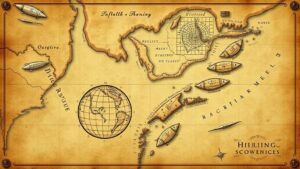How Shipwreck Databases Like NOAA’s Can Lead to Underwater Treasure
Introduction
The exploration of underwater treasure linked to shipwrecks has fascinated historians, archaeologists, and treasure hunters alike. With the advent of shipwreck databases, such as those maintained by the National Oceanic and Atmospheric Administration (NOAA), discovering and recovering treasures from these submerged sites has become more systematic and informed. This article examines how these databases facilitate underwater treasure recovery by providing historical data, navigation routes, and specific locations of shipwrecks.
Understanding Shipwreck Databases
Definition and Purpose
Shipwreck databases are comprehensive repositories of information regarding sunken vessels. often catalog the ships name, type, amount of cargo, date of sinking, and geographical coordinates. The primary purpose of such databases is to aid in maritime heritage preservation, disaster response, and archaeological research.
NOAA’s Contributions
NOAA manages a national shipwreck database known as the “National Register of Historic Places,” which registers significant shipwrecks along with their historical context. For example, NOAAs Office of National Marine Sanctuaries recognizes over 250 shipwrecks within the National Marine Sanctuary system, providing critical data to researchers and underwater explorers.
The Historical Significance of Shipwrecks
Throughout history, shipwrecks have played pivotal roles, particularly during the Age of Exploration. Vessels such as the Spanish galleon San José, sunk in 1708 off the coast of Colombia, are estimated to carry treasure worth billions today. Historical records indicate that upon its sinking, the ship was loaded with gold, silver, and emeralds, reflecting the wealth that was frequently transported across perilous ocean routes.
How Shipwreck Databases Aid in Recovery
Data-Driven Treasure Hunting
Shipwreck databases provide valuable data for treasure hunters. The detailed records include the ships last known coordinates, which can be cross-referenced with sonar mapping technology to locate the exact resting place of sunken vessels. For example, the successful recovery of artifacts from the wreck of the Queen Annes Revenge, the flagship of pirate Blackbeard, was facilitated by information provided through databases like those maintained by NOAA.
Legal and Ethical Considerations
Engaging with shipwreck databases also involves navigating the legal landscape surrounding underwater treasure hunting. The UNESCO Convention on the Means of Prohibiting and Preventing the Illicit Import, Export and Transfer of Ownership of Cultural Property emphasizes the protection of underwater cultural heritage. So, databases like NOAAs not only empower treasure seekers with information but also promote adherence to laws governing archaeological recovery.
Case Studies of Successful Recoveries
The Atocha
The wreck of the Nuestra Señora de Atocha, which sank in 1622 near the Florida Keys, serves as a prime example. Utilizing historic records stored in databases, treasure hunter Mel Fisher located the wreck in 1985, subsequently recovering over $450 million in gold and silver coins. This case illustrates the financial potential tied to structured research and exploration enabled by shipwreck databases.
The Titanic
Although primarily known for its tragic sinking, the wreck of the RMS Titanic offers insights into how databases can lead to important archaeological findings. NOAA collaborates with various organizations to study the Titanic wreck, contributing to ongoing research that educates the public about maritime history and preservation techniques.
Real-World Applications and Future Prospects
Technological Innovations
Advancements in technology, such as underwater drones and remote-operated vehicles (ROVs), have improved recovery efforts. e technologies can survey vast underwater landscapes, minimizing the time and cost associated with expeditions. For example, in 2019, researchers utilized an ROV outfitted with advanced sonar to map undiscovered shipwrecks based on data from the NOAA database.
Educational Opportunities
Shipwreck databases also serve an educational purpose, providing universities and academics with resources to conduct maritime archaeology courses. By studying real cases, students gain practical knowledge and skills, preparing them for careers in underwater exploration or maritime history.
Conclusion
Shipwreck databases like those maintained by NOAA are invaluable tools that have reshaped how treasure hunters, archaeologists, and historians approach underwater recovery. synergy between historical documentation, technological advancement, and treasure hunting not only leads to archaeological discoveries but also supports the preservation of maritime heritage. As future explorations unfold, the potential for uncovering remarkable treasures remains as promising as ever.
Actionable Takeaways
- Use shipwreck databases as primary resources for conducting thorough research prior to any underwater exploration.
- Stay informed about legal regulations regarding treasure hunting to ensure ethical recovery practices.
- Consider technological advancements and their applications in underwater exploration to enhance recovery efficiency.
- Engage with educational resources that incorporate shipwreck database data to promote awareness and interest in maritime archaeology.


